Jet Bridge Blues
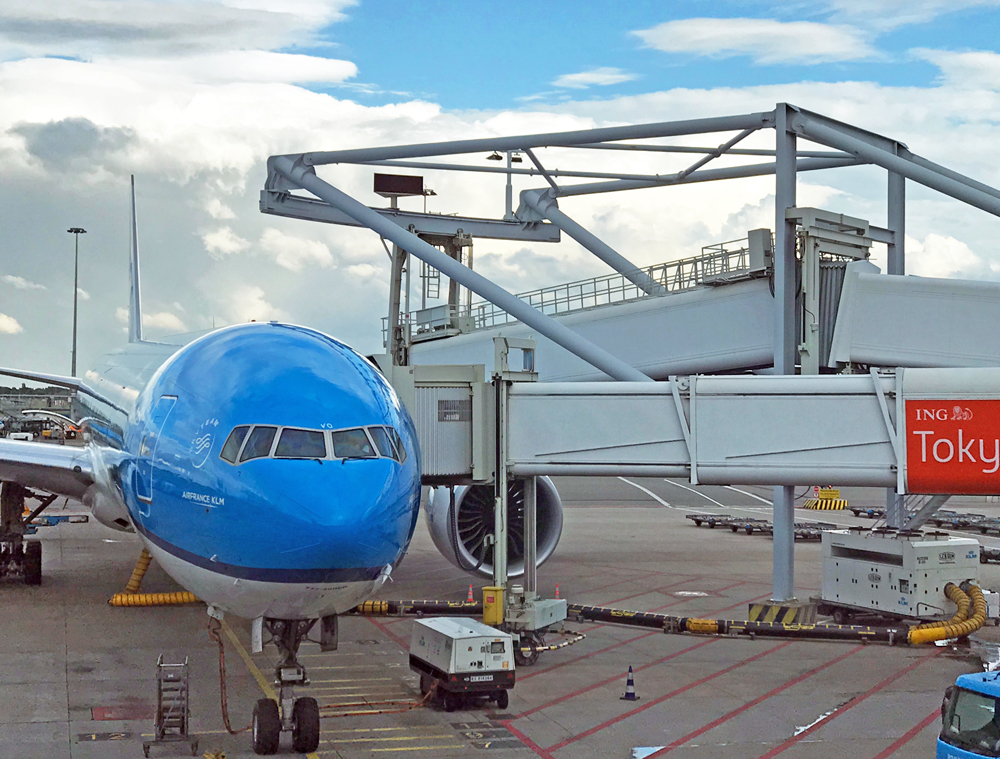
May 15, 2023
PHOTOS BY THE AUTHOR.
THE JET BRIDGE, that strange, too-often troublesome umbilicus connecting terminal to fuselage.
The other day I was stuck on a regional jet for twenty minutes because the gate agent couldn’t get the damn thing into the right position. If only I had a dollar for every time this has happened. And much of the problem, I think, is that these devices are so monstrously over-engineered. Take a look at the typical jet bridge. The things are enormous. They must weigh hundreds of thousands of pounds and cost millions of dollars.
(Note: I’ll be using the generic term rather than “Jetway,” which is a brand.)
That wayward bridge at JFK was twice the size of the plane. As the agent fumbled with the thing, it looked like she was trying to steer a battleship. Hydraulic arms flexed and groaned, machinery wailed, lights flashed and bells rang. Finally the tires began to turn — like the wheels of those huge mobile barges that NASA used to position the Saturn rockets. All of this so that fifty people could walk the negligible distance from the aircraft to the terminal.
I realize the bridges are multifunction. The air conditioning and power connections used by the plane during its downtime are part of the assembly. But do they need to be so big and heavy, with all of this Rube Goldberg machinery? It’s just a gangway for crying out loud. You see simpler, lightweight, often glass-sided jet bridges in Europe and elsewhere around the world (see the following photo), but here in the U.S. we rely on these ponderous, lumbering contraptions.
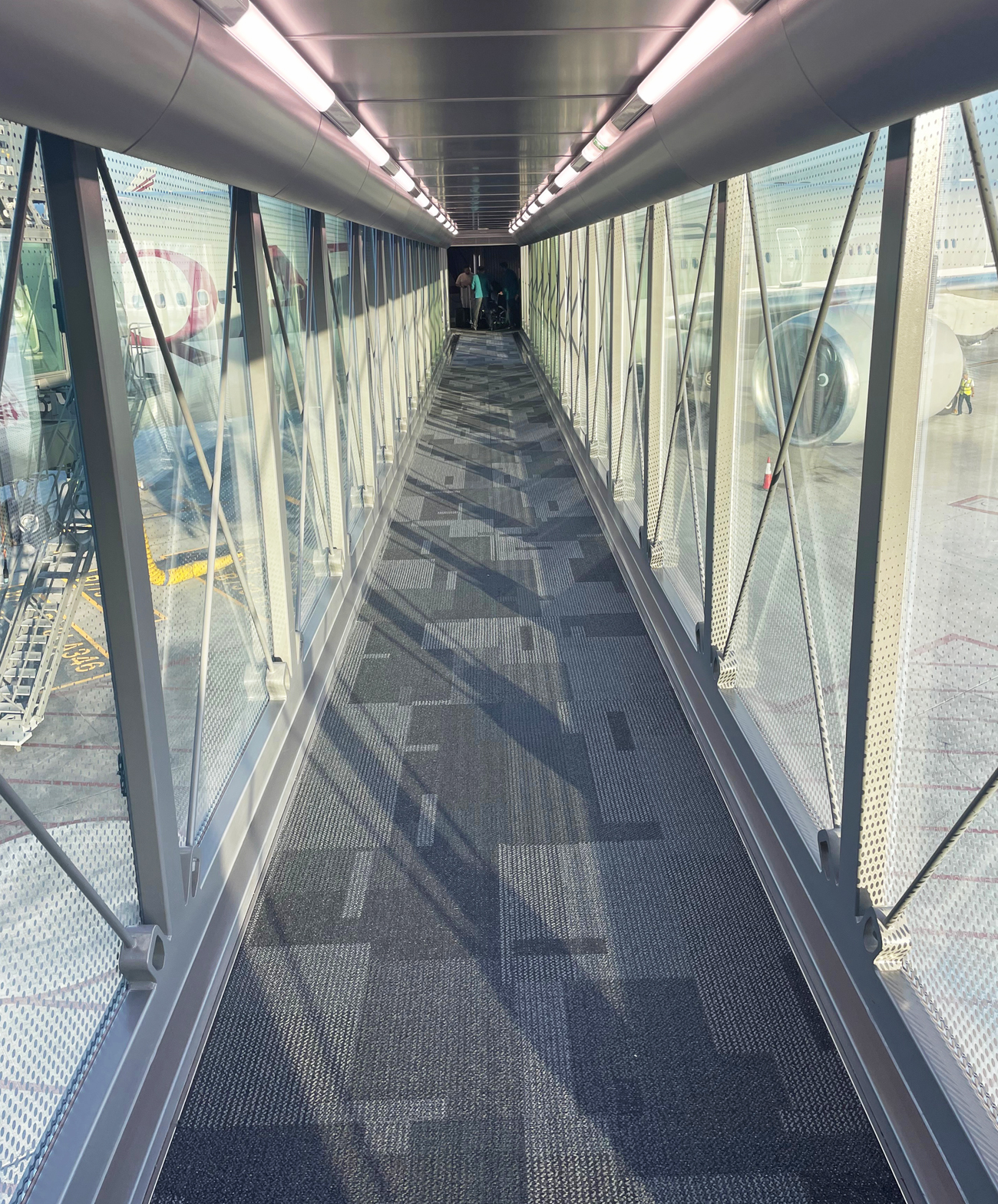
Of course, I’m opposed to jet bridges on principle. I prefer the classic, drive-up airstairs. Some of the international stations I fly to still employ those old-timey stairs, and I always get a thrill from them. There’s something dramatic about stepping onto a plane that way: the ground-level approach along the tarmac followed by the slow ascent. The effect is like the opening credits of a film — a brief, formal introduction to the journey. The jet bridge makes the airplane almost irrelevant; you’re merely in transit from one annoying interior space (terminal) to another (cabin).
Plus, it takes me back to my first-ever ride on an airplane. It was 1974 and I was eight years-old, and I vividly remember walking up the stairs to that American Airlines 727. A photo snapped by my mother immortalizes the moment…

I know, the bridges are important for passengers with limited mobility or who rely on wheelchairs, and for avoiding inclement weather. But the old-style stairs worked well for decades, and I see no reason they couldn’t still. Hydraulic lifts could be used for wheelchairs while the rest of us climb the stairs. I’m convinced this would be a faster and more efficient method. Ryanair is one carrier that agrees with me. The European budget giant relies on stairs, not bridges, at most of its stations.
But if we’re going to rely on jet bridges, we ought to have not only simpler ones, but more of them. Airports outside the U.S. routinely board and deplane a widebody jet through multiple doors using multiple bridges — at least two, and sometimes even three. This makes a massive difference in how long it takes to move hundreds of people, and their hundreds of carry-ons, between the terminal and the cabin. Here at home it takes 45 minutes to get a few dozen people onto a regional jet, and it’s chaos the entire time, while in Asia I’ve seen 500 passengers board an A380 in under thirty minutes. Dual-bridge boarding does exist in the United States, but it’s uncommon.
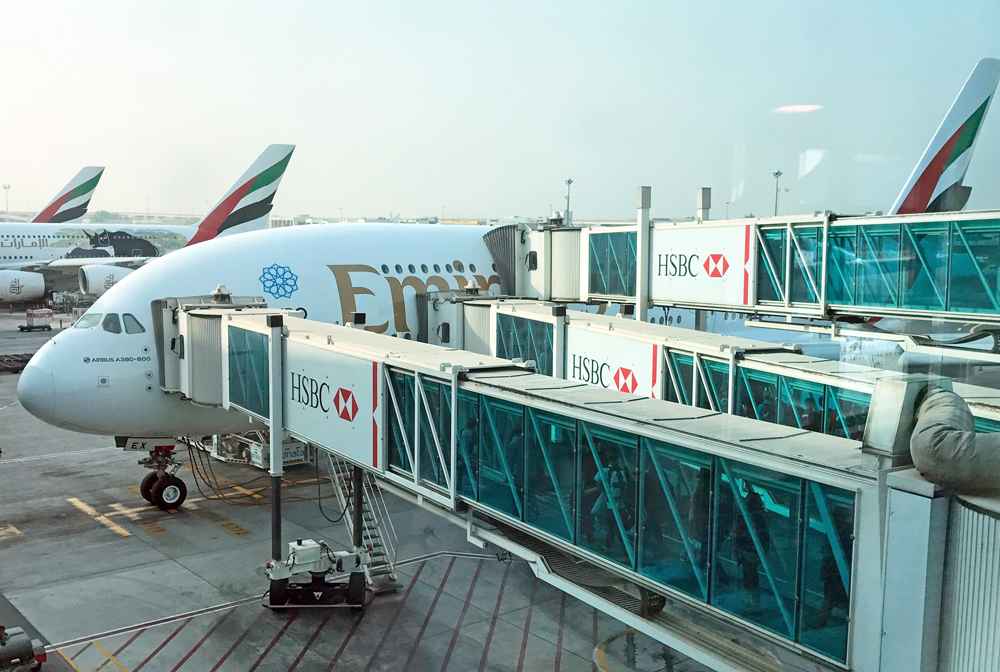
In Amsterdam, KLM boards some of its flights using forward bridges, plus a unique, over-the-wing bridge that connects to the rear fuselage. These overwing bridges are by no means lightweight, slung from a superstructure that looks like something you’d see in a shipyard where they build aircraft carriers, but they do make getting on and off the jet quicker and more pleasant.
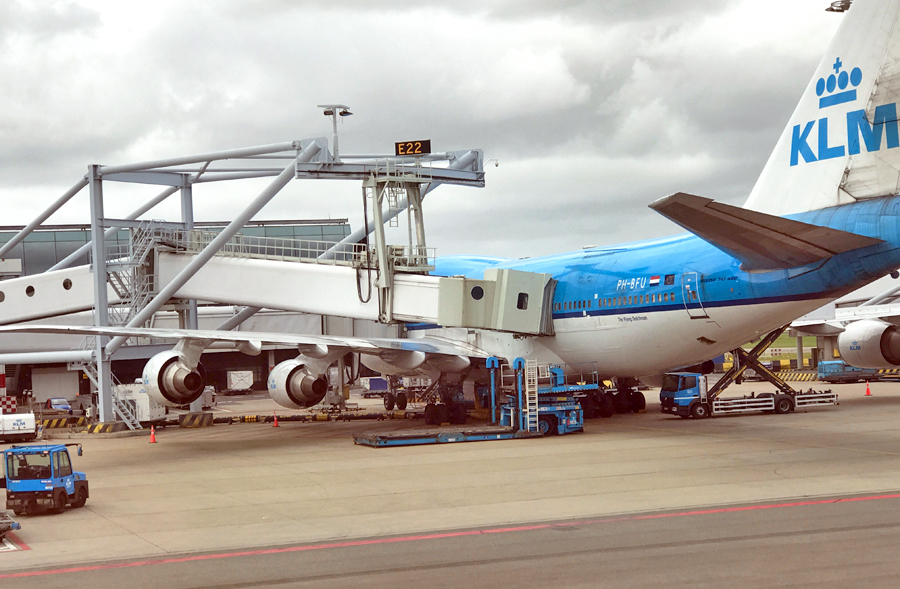
Another reason that boarding is more efficient in other countries, Asia especially, is that carriers there tend to use bigger planes. In Asia, even a 45-minute hop is often aboard a 777 or A330. Widebody planes, with dual aisles and all-around greater spaciousness, are by their nature easier to get on and off. In the U.S., aircraft size has been steadily shrinking over the past three decades. More people are flying than ever before, it’s true, but we’re doing it on smaller planes: regional jets, A319s, 737s and the like. The reasons for this are a subject for another time, but the narrow aisles and limited bin space mean longer boarding and deplaning times.
A few years back, my friend Harriet Baskas penned this interesting story for USA Today on the history of the jet bridge.
In closing, just an observation…
Look around, and it seems that 90 percent of the world’s jet bridges are emblazoned with logo of HSBC.
I’m not sure this advertising strategy has been all that effective, however, because although millions of people see these four letters every day, relatively few of them know what they’re looking at. I did a little impromptu research, asking several colleagues if they knew what HSBC was. Not one of them could tell me.
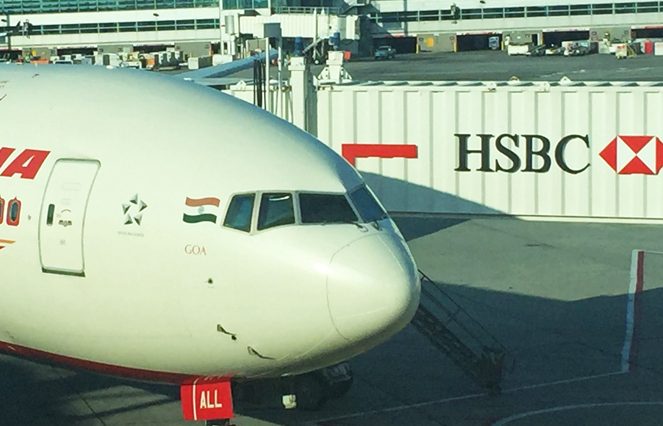
HSBC is a British bank, originally founded in Shanghai and Hong Kong. The letters stand for “Hong Kong and Shanghai Banking Corporation.” It’s one of the ten biggest banks measured by assets. The company pays tens of millions of dollars every years to airport authorities the world over — mostly at major international hubs — for the rights to put its name on boarding bridges.
In 2012, HSBC was hit with a $1.9 billion fine for laundering money on behalf of drug cartels and terrorist groups — carrying on a tradition of questionable practices that goes back generations, apparently, to the days of the opium trade.



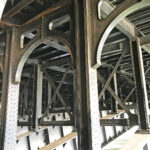

Leave a Comment
Maximum 1500 characters. Watch your spelling and grammar. Poorly written posts will be deleted!
34 Responses to “Jet Bridge Blues”
You are viewing newest comments first. Click to reverse order
The small new airport terminal at Paine Field in Everett near Seattle (now for some reason branded Seattle Paine Field) has glass jet bridges. I suspect as it was designed after the fire rules were loosened to allow transparent bridges that they decided that the smaller cheaper option was best. However it has only two of them and the airport handles less than 30 flights per day.
https://www.bizjournals.com/seattle/news/2023/07/18/paine-field-airport-gets-new-name.html
Flanders and Swann were indeed really funny (the Reluctant Cannibal is my favorite), but I don’t recall the description of forklift boarding.
Easyjet, like RyanAir, frequently uses drive-up stairways well away from the main terminal building. They embark or deplane even a small aircraft like an A320 using two doors, which speeds things up. I’ve always figured that they pay a lower fee for not using gate with Jetway. And while on the subject of trademarks, why do almost all those European and mideast airports use COBUS busses to carry passengers, packed more tightly than on a Tokyo subway, to and from the plane?
I’m one of those people for whom stairs (recently used at Zurich) are a nightmare: with a carry-on bag, arthritic knees and a walking-stick, I always have to ask a crew member to carry my bag. Bloody awkward!
WHERE I live in England HSBC is a major High Street brand and familiar to most, though most probably wouldn’t know what the initials stand for.
I Wonder why in SFO connecting to the jet bridges is taking so Mich time . Never see that elsewhere. Plane was an Airbus 350-900.
Flew on Ryanair a couple times last week. No jet bridges
I just flew to the new airport terminal in Kansas City. They have glass-walled jetbridges – the only ones I’ve ever seen in the United States. Very nice!
I should propbably wait for one of the ask me anything posts, but this experience struck me: I recently flew SFO to europe, and Frankfurt was involved as one of intermediate airports.
Departing SFO, it seemed the taxiing was infinite. I was like, they can’t taxi all the way to LHR but they sure seem like they’re trying. From simple observation taxi speed was about 15 mph. Later that day, or perhaps the next day, my flight landing in Frankfurt taxied further and faster, maybe 30-40 mph by the eye test.
So posing my question to the pilot, is there an ordained limit on taxi speeds? Does it vary by airport? By conditions? Because the frankfurt plane (airbus 320Neo) was hauling ass, while the SFO plane (777-200X) was creeping.
I fly virtually only EasyJet (A320) these days, & climb stairs more often than not.
The other day I was interested to note that the passengers with mobility problems were placed aboard one of those rise-up-like-Lazarus contraptions used for catering, etc. They were the first to board, through the right-front door.
The Amarillo Texas airport has glass jet bridges:
https://airlinegeeks.com/2019/01/27/america-turns-to-the-clear-alternative-to-steel-sided-jet-bridges/
I totally agree with your preference for Airstairs over Airbridges, partly for the reasons that you say, but mainly for speed. Waiting in a departure lounge at Newcastle (UK) airport for a Ryanair flight to Tenerife (Canary Islands, Spain), I saw the fastest turnaround I’ve ever seen, thanks to Ryanair’s use of Airstairs front and back, and an on the ball ground staff. Less than 6 minutes after the Boeing 737-800 rolled to a halt, all of a nearly full flight had debarked, their baggage was all off, the garbage was off, the plane ‘cleaned’, they started putting our flights bags on and we started boarding. Ryanair efficiency at its best!
Hi Patrick – Was marveling last evening at how long it takes to deplane an A320 – close to 25 % + of the time of the flight from MIA to BOS – insane. Funny – my first flight was about a year after yours…AA 727 round trip BOS-DCA. Curt Gowdy was on the plane coming back.
That’s one reason I love using Burbank when I go to LA, I feel like I’ve traveled to another time. I expect to run into Cary Grant or Lana Turner…
Stairs are fine for young, able-bodied people. Imagine getting Stephen Hawking up (or down) one of those steep stairways. And while I’m able-bodied, descending those always makes me a little nervous.
Long Beach airport in Southern California doesn’t use jet bridges….its the “old fashioned way” of getting on and off airliners. Southwest loads from the front and rear doors, I always board through the rear so I get a chance to actually walk most of the aircraft length on the ground and look at the marvel of engineering we all take for granted. And going up the rear stairs is a visceral feeling of really entering an actual aircraft rather than just going from one metal tube to another.
The Wikipedia article on jet bridges actually mentions the HSBC thing. It appears that in the early 2000s HSBC was looking for a global space to advertise. Their head of marketing noticed that jet bridges were pretty universal and untapped ad medium.
Just flew through Dublin yesterday, and noticed that the bridges – at least in the US preclearance section, but it looked pretty standard for what I could see from the gate windows – didn’t really have windows, either. So there are non-US airports that don’t follow the windowed trend, too.
@Tom –
Thanks for the Buffalo comment – that sounds like a good description.
In Hong Kong, because of the bank’s management hiring policy right up until around 2000, HSBC was known as “Home of Scottish Bank Clerks”.
Donald Swann, of the English comedy duo Flanders and Swann, and who happened to be confined to a wheelchair, described being loaded into an airliner via forklift. It didn’t seem to be a problem for anyone, and certainly made the boarding process more interesting. Of course, that was sometime around 1960…It’s on their old album “At the Drop of a Hat,” and is quiet entertaining.
I don’t mind windowless jet bridges nearly as much as windowless *terminals*. If I can at least get a glimpse of the plane I’m about to board, the (usually) short walk from departure lounge to airplane doesn’t seem so dreary.
(As an aside, when HSBC had a major presence in Buffalo, NY years ago, the joke was that the letters stood for “Holy (blank), Buffalo’s cold!”) 😉
From what I’ve read, jet bridges with windows were not allowed by US fire codes until recently, which is why most US airports don’t have them. Kansas City built their new terminal after the rule was changed, which is how they got to be the first airport in the US to have glass jet bridges.
I assume our big metal boarding bridges are overbuilt because of our American fascination with “safety”. I’d love nice glass ones like are often used overseas.
As for rube-goldberg, you gotta be able to get the thing level to many planes, so you have to have the jacks and hinges. What could be done is automating the positioning of the bridge. If it knows the plane model before arrival, it can elevate to the correct position early, and swing to a designated distance from the presumed door position well BEFORE the plane arrives. This would give an early head’s-up if it was malfunctioning. Then, when the plane is at its parked (is that the correct term) position, it could use a pretty simple sensor to automatically extend to meet the plane’s door.
That gives an opportunity to see major malfunction before the plane lands AND relieves the ground crew from needing to be on the bridge to guide it to the plane.
Please know I have appreciated this site with all your insight and tales for years. Thanks!
To Alex and James D, Kansas City’s new airport terminal jet bridges have windows. First in The US. Wonder what the longest jet bridge walk is that doesn’t zig-zag?
I’ve always loved flying in and out of EYW at Key West, because you still use the stairs and walk across the tarmac. It just feels right.
Alas, there’s a new terminal in process, and the mockup in the lobby shows jet bridges.
One of the more enjoyable parts of flying out of KASE is the boarding process. You walk out the gate door, hand your “carry on” to the ground crew member who loads it into the belly. Then climb a switchbacked ramp to board. Not quite as optically glamorous as the stairs, but you’re out in the elements for a few minutes, and get a really good look at the RJ that’s going to take you to your destination. Unfortunately the ramps might be going away with the terminal remodel scheduled for whenever everyone agrees on a plan (knowing Aspen politics, might take a few more decades).
At a lot of Australian airports, for 737s and a320s, there’s a jet bridge and stairs. If you’re seated in rows 1-15, you board via the jet bridge; if you’re in rows 16-30, you go down some steps, walk around the wing, and board via stairs at the rear door.
It does seem to significantly speed up boarding and disembarkation, and it means you sometimes get the chance to walk around the plane, which is fun. And if it’s raining heavily, they just board everyone through the jet bridge and the front door.
—Look around, and it seems that 90 percent of the world’s jet bridges are emblazoned with logo of HSBC.—-
I’m not sure whether it’s changed – it’s been a while since I’ve flown through Hong Kong. But for a long time, I thought it was weird that almost all the jet bridges I walked across around the world were sponsored by HSBC, except the ones at Hong Kong Airport. While HSBC’s de facto headquarters (not its official ones) are in Hong Kong, and it’s the biggest retail bank there, it sponsored every city’s jet bridges except its own. They were sponsored by ICBC, a Mainland Chinese Bank, if I recall correctly. I don’t know why this was.
As it is, though, it’s nice that, at almost every airport I fly through, I am reminded as I board the plane of the company whose insurance subsidiary stiffed me after a burglary.
London based (very frequent) flier. I agree there’s something quite magically dramatic walking up the stairs to plane. Love the Doha remote gates where it could be a 777 or a350
That said, I boarded my VIE-LGW wizzair flight back to London the other night in torrential rain. I’m certain rain exacerbates the haplessness of that hapless cohort who struggle boarding an plane in sunshine.
Aberdeen airport doesn’t have jet bridges and precipitation there is de rigueur – I keep swearing on bringing an umbrella when using that airport cause its always bucketing down at boarding.
I understand jet bridges are a necessary evil in modern air travel. What I don’t understand is why in the US we couldn’t be bothered to build ours with windows like the rest of the world?
I’ve been flying since I was 3 years old. (71 now). I agree that the stairs are much better way to enter/exit an aircraft, at least for those of us who are interested in aircraft. However, given the amount of luggage and bags passengers are carrying, climbing and descending stairs would surely cause many accidents and injuries. Sigh…
Boarding and un-boarding should be done inside a ginormous hangar-like building to take the annoyance of rain, snow, bright sun, dark nights and high winds out of the equation. To further simplify and speed the process, passengers should be seated in pods that are installed and removed from airliners using a combination of cranes, tow motors and forklifts. Same for baggage, meals and freight.
Implementation of the above would return time-to-refuel to its rightful place as the only barrier to fast and efficient aircraft operation. Well, except for finding a crew to replace the one that is stuck holding at the final approach fix.
Well if we shall board using stairs, at the very least I want it to be those old narrow rickety stairs that come out of the aircraft itself, like on the old DC-9 or some early 737 models (argh, how I otherwise hate the 737). They have to be narrow, jittery, and instill least confidence in the air frame you’re about to board. 😉
No, seriously, if boarding with stairs, just make sure to board with TWO sets. One front and one rear. Just like EasyJet does in Europe. Especially when boarding a single-aisle aircraft, this makes it so much more efficient.
And shout out to SFO as one of the very few US airports that – like the Europeans – manages to use more than one jet bridge to board heavies. As to US fire codes having prohibited glass walls on jet bridges – what a bunch of silly nonsense. As if anybody ever was less safe on a EU jet bridge. With our gun death toll, I think we know where we’d really need to invest in beefing up our safety compared to Europe.
What I really like about jet bridges outside the USA is that they almost always have full-length windows on each side. (as shown in your 2nd picture of this article). Here in the United States, we have solid walls on each with very little if any windows. It seems like full glass jet bridges are just the standard everywhere but here.
I know it’s a small detail when traveling, but I do enjoy seeing the action around the ramp, seeing other planes taxiing, watching luggage carts drive around, to see the plane I’m about to board as we walk towards it (kind of like air stairs!). But also for some natural light during the day too, it makes them feel less enclosed.
In Indonesia, the jetway is a luxury in most airports and we still commonly use stairs. Its a very cool experience hearing a 737 or A320 engine while going up the stairs